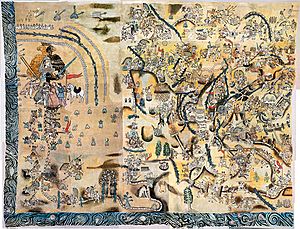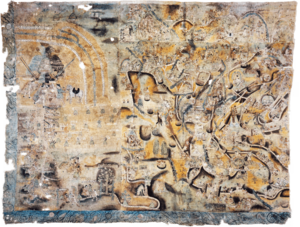Lienzo de Quauhquechollan facts for kids
The Lienzo de Quauhquechollan is a special cloth painting from the 1500s. It was made by the Nahua peoples, who are native people from Mexico. This painting is one of only two Nahua pictures that tell the story of the Spanish conquest of Guatemala. It's also the oldest map we have of what is now Guatemala.
The Lienzo was likely painted in a place called Ciudad Vieja in modern Guatemala. It was created by Nahua people from the city of Quauhquechollan. These Nahua people were friends and helpers of the Spanish. They helped a Spanish leader named Jorge de Alvarado in his battles from 1527 to 1529.
The Quauhquechollan allies later settled in the mountains of Guatemala. Their painting shows how they helped the Spanish take over parts of Mexico and Guatemala. Today, you can see the original Lienzo in the Museo Regional de Cholula, in Puebla, Mexico.
A Dutch expert named Florine Asselbergs figured out the meaning of the Lienzo de Quauhquechollan in 2002. She was the first to realize the painting showed Jorge de Alvarado's battles. She also saw how important the Quauhquechollan people were in the Spanish conquest. Her amazing work was published in a book called Conquered Conquistadors in 2004. This book is considered one of the best about the Spanish conquest of Guatemala.
In 2007, a university in Guatemala, the Universidad Francisco Marroquín, made a digital version of the Lienzo. This new version looks like the original but is easier to see. You can find it at the university in an exhibit called 'Quauhquechollan, a chronicle of conquest'. The exhibit also has a life-size picture of the real Lienzo. It offers fun, interactive ways to learn about this historical painting.
How the Lienzo Was Made
The Lienzo de Quauhquechollan was created around the 1530s. It is made from 15 separate pieces of painted cotton fabric. These pieces were sewn together to form one big map. The cotton pieces are different sizes, and some were even used before for other things.
The full Lienzo de Quauhquechollan is about 3.25 meters (10.7 feet) wide and 2.35 meters (7.7 feet) tall. It was painted in a style common in central Mexico. It uses traditional Nahua art methods to show both Nahua and Spanish people and events. The map mainly focuses on modern Guatemala, especially the area around Chimaltenango. It also shows Santiago de los Caballeros de Guatemala, which was an important city back then.
The Lienzo highlights the role of the Quauhquechollan allies in the conquest. It shows their journeys and the battles they fought. More than one artist worked on the painting. You can tell this because the painting styles are a bit different in various parts.
What the Lienzo Shows
In the top left corner of the Lienzo, you can see a special symbol for Quauhquechollan. It's combined with the Habsburg family symbol, which was used by the Spanish rulers. One part of the painting shows the Spanish leader Hernán Cortés hugging a Quauhquechollan noble. Both have their groups of followers, and they are exchanging gifts.
Another scene shows Jorge de Alvarado leading a big army as they leave Quauhquechollan. This army was a mix of Spanish and Nahua soldiers. All the Quauhquechollan warriors are shown carrying Spanish swords. This was a special honor given to some native allies of the Spanish.
The painting also shows the army's path on its way to Guatemala. It includes places like Tehuantepec in Oaxaca and the Soconusco region in Chiapas. These areas are now part of Mexico. In Guatemala, the army travels through Retalhuleu, Zapotitlán, and Suchitepéquez. It enters the lands of the K'iche', Kaqchikel, and Pipil kingdoms. It also shows the Verapaz region and the Cuchumatanes mountains. The army is shown fighting in many battles.
Even though Pedro de Alvarado, Jorge de Alvarado's brother, had conquered parts of Guatemala earlier, by 1527, much of the area was fighting back. The Lienzo shows the first major conquest of Guatemala. It tells us that Jorge de Alvarado and his allies should get credit for this. For a long time, historians thought his brother Pedro did it. The Lienzo also reveals how important the Nahua warriors were in the Spanish conquest. Their role was much bigger than people thought before.
See also




